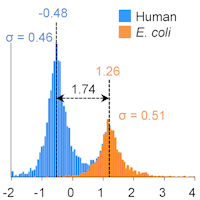Mass spectrometry-based Proteomics
We develop algorithms and software for the analysis of vast amounts of mass spectral data that are produced in modern proteomics experiments. The MaxQuant software that we develop is one of the most widely used platforms in computational proteomics. Many labs world-wide benefit from its precise protein and peptide quantification algorithms. It is freely available for academic and non-academic researchers at MaxQuant.

Today MaxQuant supports nearly all types of shotgun proteomics data, including MS1-level based labeling data, like SILAC and di-methyl, isobaric labeling data, like iTRAQ and TMT, and label-free data. Recently, we added support for data-Independent acquisition proteomics data with the MaxDIA workflow. Supported mass spectrometry vendors include Thermo Fisher Scientific, Bruker Daltonics and AB Sciex. The peptide search engine Andromeda, which uses a probability-based scoring of peptide-spectrum matches, is integrated into MaxQuant.
Sophisticated mass recalibration algorithms dramatically improve the accuracy of the mass measurements of peptides and contribute to their reliable identification. We develop algorithms for the de-novo identification of peptides from fragmentation spectra, which rival commercial products in terms of sensitivity and specificity. Several other algorithms are developed that serve the goal of identifying all peptides that occur in an experiment, including those with novel posttranslational modifications as well as those originating from natural and disease-related genomic variants.
Furthermore, new quantification techniques are being developed improving state of the art methods, for example alleviating the co-fragmentation problem inherent to isobaric labeling. Ion mobility-enhanced shotgun proteomics data is analyzed in extensions of the MaxQuant software leading to particularly high sensitivity in DDA and DIA data, which Is particularly useful for applications in single-cell proteomics.
Cross-linking mass spectrometry is a research focus in my group. There still is a lack of standardized, scalable and freely available software solutions, both for non-cleavable and mass spec-cleavable cross-linking proteomics studies. We are currently working on software for the very-large scale quantification of proteins and posttranslational modifications over all publicly available data.
Selected publications:
Cox, J. and Mann, M. (2008). MaxQuant enables high peptide identification rates, individualized p.p.b.-range mass accuracies and proteome-wide protein quantification. Nature Biotech 26, 1367-72.
Cox, J., Hein, M.Y., Luber, C.A., Paron, I., Nagaraj, N. and Mann, M. (2014) MaxLFQ allows accurate proteome-wide label-free quantification by delayed normalization and maximal peptide ratio estimation. Mol Cell Proteomics.
Cox, J., Neuhauser, N., Michalski, A., Scheltema, R.A., Olsen, J.V. and Mann, M. (2011) Andromeda – a peptide search engine integrated into the MaxQuant environment. J Proteome Res 10, 1794-1805.
Cox, J., Michalski, A. and Mann, M. (2011). Software lock mass by two-dimensional minimization of peptide mass errors. J Am Soc Mass Spectrom 22, 1373-80.
Cox, J. and Mann, M. (2011). Quantitative, high resolution proteomics for data-driven systems biology. Annual Review of Biochemistry 80, 273-299.
